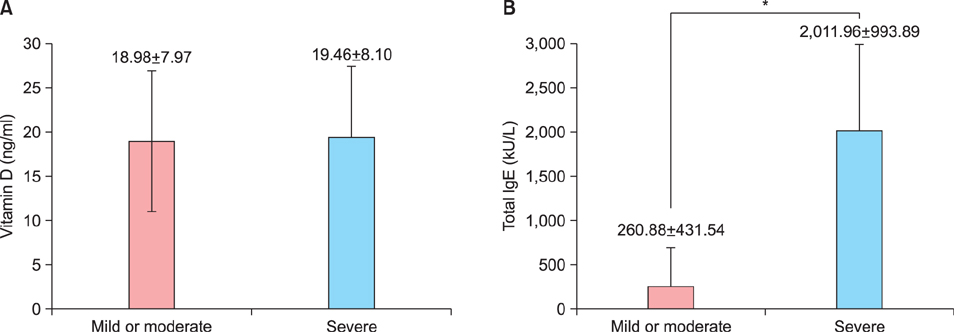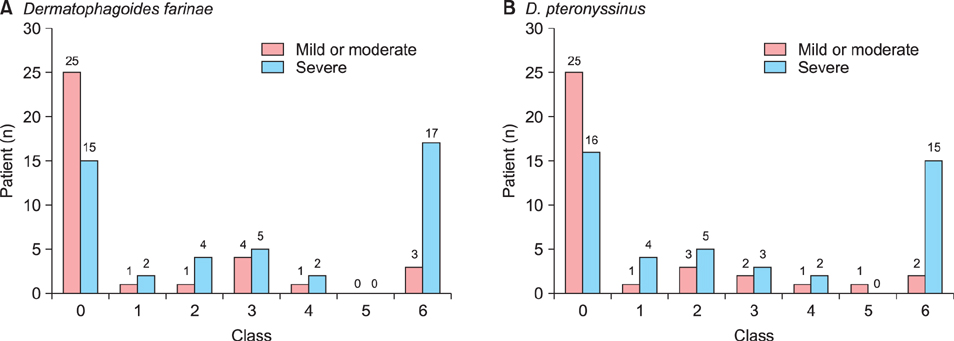Ann Dermatol.
2017 Aug;29(4):400-406. 10.5021/ad.2017.29.4.400.
House Dust Mite Sensitization Is Inversely Associated with Plasma 25-Hydroxyvitamin D3 Levels in Patients with Severe Atopic Dermatitis
- Affiliations
-
- 1Department of Dermatology, Kyungpook National University School of Medicine, Daegu, Korea. shkim72@knu.ac.kr
- 2Department of Pharmacology, Kyungpook National University School of Medicine, Daegu, Korea. kimdw@knu.ac.kr
- KMID: 2388936
- DOI: http://doi.org/10.5021/ad.2017.29.4.400
Abstract
- BACKGROUND
The relationship between atopic dermatitis (AD) and low vitamin D levels has been studied. Emerging evidence has implicated vitamin D as a critical regulator of immunity, playing a role in both the innate and cell-mediated immune systems. However, the effect of vitamin D on house dust mite (HDM) sensitization in patients with AD has not been established.
OBJECTIVE
We investigated the association between vitamin D levels and HDM sensitization according to AD severity.
METHODS
In total, 80 patients (43 men and 37 women) with AD were included. We classified AD severity using Rajka and Langeland scores. Laboratory tests included serum 25-hydroxyvitamin D3, total immunoglobulin E (IgE), and specific IgE antibody titer against Dermatophagoides farinae and D. pteronyssinus.
RESULTS
There were no differences in vitamin D levels between the mild or moderate AD and severe AD groups. In the severe AD group, high HDM sensitization group had lower serum vitamin D levels compared to low HDM sensitization group with statistical significance. In addition, a significant negative correlation was found between vitamin D levels and HDM sensitization in the severe AD group.
CONCLUSION
Our results demonstrate that low vitamin D levels may link to high HDM sensitization in patients with the severe AD. Further elucidation of the role of vitamin D in HDM sensitization may hold profound implications for the prevention and treatment of AD.
Keyword
MeSH Terms
Figure
Reference
-
1. Benson AA, Toh JA, Vernon N, Jariwala SP. The role of vitamin D in the immunopathogenesis of allergic skin diseases. Allergy. 2012; 67:296–301.
Article2. Searing DA, Zhang Y, Murphy JR, Hauk PJ, Goleva E, Leung DY. Decreased serum vitamin D levels in children with asthma are associated with increased corticosteroid use. J Allergy Clin Immunol. 2010; 125:995–1000.
Article3. Muehleisen B, Gallo RL. Vitamin D in allergic disease: shedding light on a complex problem. J Allergy Clin Immunol. 2013; 131:324–329.
Article4. Peroni DG, Piacentini GL, Cametti E, Chinellato I, Boner AL. Correlation between serum 25-hydroxyvitamin D levels and severity of atopic dermatitis in children. Br J Dermatol. 2011; 164:1078–1082.
Article5. El Taieb MA, Fayed HM, Aly SS, Ibrahim AK. Assessment of serum 25-hydroxyvitamin d levels in children with atopic dermatitis: correlation with SCORAD index. Dermatitis. 2013; 24:296–301.
Article6. Wang SS, Hon KL, Kong AP, Pong HN, Wong GW, Leung TF. Vitamin D deficiency is associated with diagnosis and severity of childhood atopic dermatitis. Pediatr Allergy Immunol. 2014; 25:30–35.
Article7. Oren E, Banerji A, Camargo CA Jr. Vitamin D and atopic disorders in an obese population screened for vitamin D deficiency. J Allergy Clin Immunol. 2008; 121:533–534.
Article8. Lee SA, Hong S, Kim HJ, Lee SH, Yum HY. Correlation between serum vitamin d level and the severity of atopic dermatitis associated with food sensitization. Allergy Asthma Immunol Res. 2013; 5:207–210.
Article9. Heimbeck I, Wjst M, Apfelbacher CJ. Low vitamin D serum level is inversely associated with eczema in children and adolescents in Germany. Allergy. 2013; 68:906–910.
Article10. Chiu YE, Havens PL, Siegel DH, Ali O, Wang T, Holland KE, et al. Serum 25-hydroxyvitamin D concentration does not correlate with atopic dermatitis severity. J Am Acad Dermatol. 2013; 69:40–46.
Article11. Searing DA, Leung DY. Vitamin D in atopic dermatitis, asthma and allergic diseases. Immunol Allergy Clin North Am. 2010; 30:397–409.
Article12. Rajka G, Langeland T. Grading of the severity of atopic dermatitis. Acta Derm Venereol Suppl (Stockh). 1989; 144:13–14.13. Pajno GB, Caminiti L, Vita D, Barberio G, Salzano G, Lombardo F, et al. Sublingual immunotherapy in mite-sensitized children with atopic dermatitis: a randomized, double-blind, placebo-controlled study. J Allergy Clin Immunol. 2007; 120:164–170.
Article14. Han TY, Kong TS, Kim MH, Chae JD, Lee JH, Son SJ. Vitamin D status and its association with the SCORAD score and serum LL-37 level in Korean adults and children with atopic dermatitis. Ann Dermatol. 2015; 27:10–14.
Article15. Mesquita Kde C, Igreja AC, Costa IM. Atopic dermatitis and vitamin D: facts and controversies. An Bras Dermatol. 2013; 88:945–953.
Article16. Liu FT, Goodarzi H, Chen HY. IgE, mast cells, and eosinophils in atopic dermatitis. Clin Rev Allergy Immunol. 2011; 41:298–310.
Article17. Park M, Lee HY, Lee SI, Kim J, Ahn K. Positive conversion of specific IgE against house dust mite in children with atopic dermatitis under 24 months of age. Allergy Asthma Respir Dis. 2013; 1:350–356.
Article18. Kim J, Lee S, Woo SY, Han Y, Lee JH, Lee IY, et al. The indoor level of house dust mite allergen is associated with severity of atopic dermatitis in children. J Korean Med Sci. 2013; 28:74–79.
Article19. Kimura M, Tsuruta S, Yoshida T. Correlation of house dust mite-specific lymphocyte proliferation with IL-5 production, eosinophilia, and the severity of symptoms in infants with atopic dermatitis. J Allergy Clin Immunol. 1998; 101:84–89.
Article20. Akan A, Azkur D, Ginis T, Toyran M, Kaya A, Vezir E, et al. Vitamin D level in children is correlated with severity of atopic dermatitis but only in patients with allergic sensitizations. Pediatr Dermatol. 2013; 30:359–363.
Article21. Baek JH, Shin YH, Chung IH, Kim HJ, Yoo EG, Yoon JW, et al. The link between serum vitamin D level, sensitization to food allergens, and the severity of atopic dermatitis in infancy. J Pediatr. 2014; 165:849–854.e1.
Article22. Baeke F, Takiishi T, Korf H, Gysemans C, Mathieu C. Vitamin D: modulator of the immune system. Curr Opin Pharmacol. 2010; 10:482–496.
Article23. Provvedini DM, Tsoukas CD, Deftos LJ, Manolagas SC. 1,25-dihydroxyvitamin D3 receptors in human leukocytes. Science. 1983; 221:1181–1183.
Article24. Ehlayel MS, Bener A, Sabbah A. Is high prevalence of vitamin D deficiency evidence for asthma and allergy risks? Eur Ann Allergy Clin Immunol. 2011; 43:81–88.25. Rullo VE, Segato A, Kirsh A, Sole D. Severity scoring of atopic dermatitis: a comparison of two scoring systems. Allergol Immunopathol (Madr). 2008; 36:205–211.
Article26. Gånemo A, Svensson Å, Svedman C, Grönberg BM, Johansson AC, Wahlgren CF. Usefulness of Rajka & Langeland eczema severity score in clinical practice. Acta Derm Venereol. 2016; 96:521–524.
Article
- Full Text Links
- Actions
-
Cited
- CITED
-
- Close
- Share
- Similar articles
-
- Patch test and Specific IgE Concentration with House Dust Mite Antigens in Atopic Dermatitis Patients
- Correlation between House Dust Mite Allergen Concentrations in Scalp Dander and Clinical Severity of Atopic Dermatitis in Children
- Correlation between serum 25-hydroxyvitamin D3 and the severity of atopic dermatitis in children with allergic or nonallergenic sensitization
- Food and house dust mite allergens in children with atopic dermatitis
- Positive conversion of specific IgE against house dust mite in children with atopic dermatitis under 24 months of age






